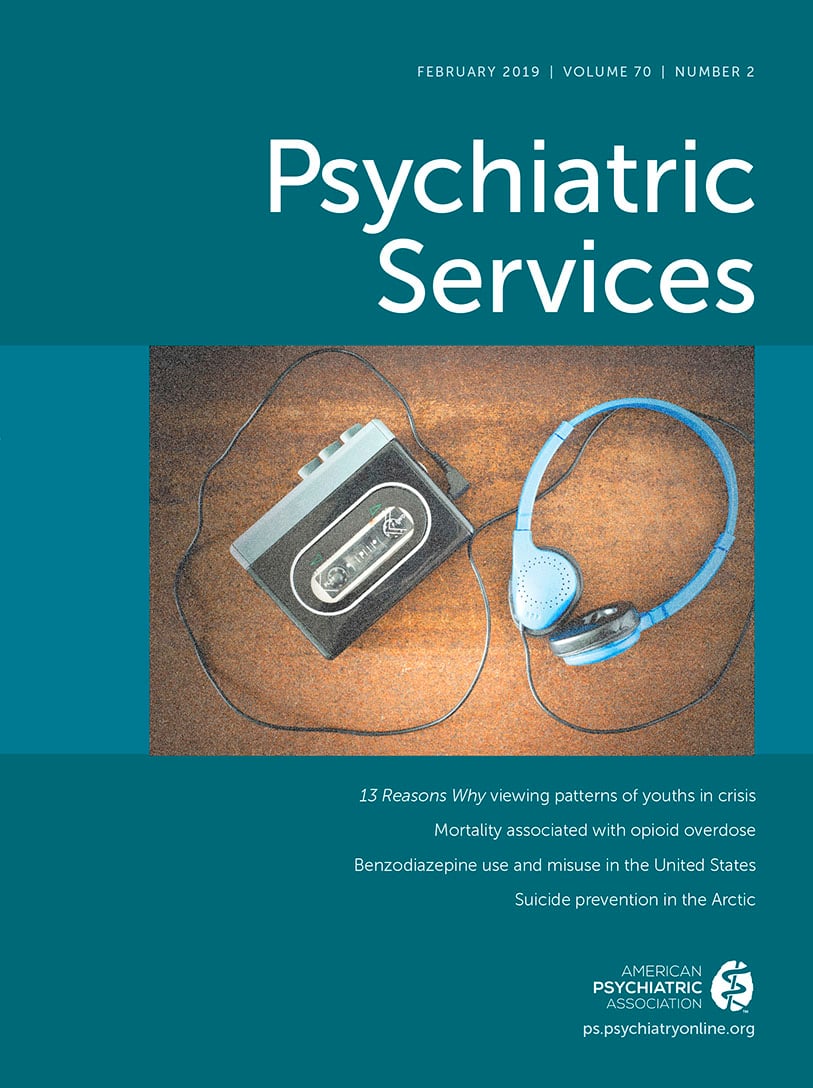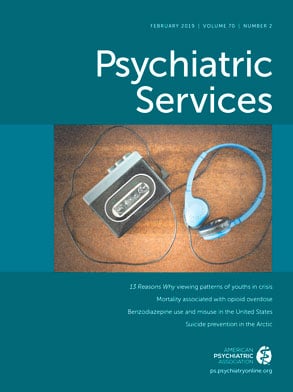Patients with a mental illness, including bipolar disorders, have a 13- to 30-year shorter life expectancy than the general population, mostly because of somatic comorbidities (
1,
2). However, psychiatric clinics demonstrate poor adherence to somatic monitoring guidelines (
3,
4). A monitoring program for psychiatric patients called Monitoring Outcomes of Psychiatric Pharmacotherapy (MOPHAR) has been implemented at all outpatient clinics of Mental Health Service Drenthe, the Netherlands, a large regional specialized mental health care institution. MOPHAR incorporates structured somatic monitoring in outpatient clinical practice in order to prevent, detect, monitor, and treat somatic comorbidities and adverse effects of psychotropic drugs, including metabolic syndrome. We aimed to assess the effects of introducing the MOPHAR program on monitoring practices at an outpatient clinic for bipolar disorders and the frequency and treatment of metabolic syndrome in the population from this outpatient clinic.
Methods
Aims and outline of the MOPHAR monitoring program are described elsewhere (unpublished data, Simoons M, Ruhé HG, van Roon EN, et al., 2018). MOPHAR was first implemented at three locations of the bipolar disorder outpatient clinic (≥200 patients), with a regional multidisciplinary team of psychiatrists, nurses, and nursing specialists. Consecutive patients who were already in treatment at these outpatient clinics and who were age 18 or older were invited to participate in MOPHAR. This study assessed MOPHAR screenings between January 2016 and June 2017.
MOPHAR research was approved by the independent medical ethics committee of Leeuwarden, the Netherlands (RTPO 928). After receipt of complete verbal and written information about MOPHAR, participants provided informed consent.
MOPHAR consists of a general somatic screening for every patient at the first appointment and yearly thereafter, irrespective of psychiatric diagnosis or medication use. This screening includes physical examination, laboratory tests, and medication reconciliation (
5). The set of parameters for the physical examination and laboratory tests is shown in
Box 1. These measurements were chosen in 2014 by a multidisciplinary working group consisting of psychiatrists, hospital pharmacists, and a clinical chemist from the northern part of the Netherlands on the basis of available monitoring recommendations from guidelines and consensus documents, literature, and expert opinion (
6–
10). MOPHAR screens for known somatic comorbidities and medication side effects and for additional somatic comorbidities that are potential causes of mental illness. Moreover, it may serve as baseline screening before the start of psychotropic drugs. The general screening is performed by a trained nurse, and the blood withdrawal is performed by nearby collaborating laboratories. The patient-specific part of MOPHAR consists of monitoring therapeutic effects by using disorder-specific questionnaires and monitoring somatic adverse effects according to prespecified protocols for psychotropic drugs.
To ensure sustainability of MOPHAR, we thoroughly informed treatment teams; provided an education program for nurses, including written job instructions; and applied a pilot before introduction. After the introduction, weekly (later monthly) evaluation meetings were organized with the treatment team. A pharmacist and project manager were available for consultation.
In this study, we focused on the physical examination, laboratory tests, and medication reconciliation from the first somatic screening after introduction of MOPHAR. First, as a feasibility/quality indicator, we compared the numbers of available physical examinations and laboratory tests collected through MOPHAR screening with somatic monitoring data gathered for the same patients around the time of their first appointment with the current primary treatment officer.
Of 31 measurements in the MOPHAR screening protocol (
Box 1), 24 measurements are performed with every outpatient. Weight and height are represented by body mass index. Data for each measurement are presented as the percentage of all patients with whom the measurement was performed. We included records from within one month before or after the MOPHAR screening appointment and around the start of treatment at the outpatient clinic. This time lag was applied to take into account the time between blood withdrawal and the appointment and the time for analysis and reporting of results.
Second, to compare the frequency and pharmacological treatment of metabolic syndrome before and after introduction of MOPHAR, we cross-sectionally assessed the presence of metabolic syndrome by using the National Cholesterol Education Program ATP-III criteria (
11). A patient was classified as having metabolic syndrome if three or more of five metabolic parameters were outside the normal range or if the patient received pharmacological treatment for these parameters. [A table listing the five metabolic syndrome components is available in an online supplement to this report.]
To assess the frequency of metabolic syndrome despite pharmacological treatment, we recalculated the prevalence of metabolic syndrome components after correction for successful pharmacotherapeutic treatment. Treatment was considered successful if the measurement was within reference ranges while the patient used one or more drugs for dyslipidemia, hypertension, or hyperglycemia. No systematic lifestyle treatments (e.g., lifestyle groups) were operational at the outpatient clinic; the effects of lifestyle training or nonpharmacological treatments of metabolic syndrome could not be assessed reliably and, therefore, were not taken into account.
We performed statistical analyses by using IBM SPSS (version 25 for Windows). We report medians (range) for the MOPHAR measurements when distributions are nonnormally distributed; otherwise, data are reported as means and standard deviations. For comparison of the number of measurements performed before and after (paired) screening, we used paired t tests. We investigated potential associations between gender and duration of disease and the presence of metabolic syndrome by using univariate logistic regression. Differences were considered statistically significant when p<0.05.
Results
A total of 189 consecutive patients were invited for MOPHAR somatic screening during the study period. Sixteen (8%) patients refused to undergo MOPHAR monitoring care, and 18 (10%) refused to give informed consent for use of their data. The remaining 155 patients were included [see online supplement for details about patient characteristics]. Patients were 50 years old on average, 78% (N=121) had a primary diagnosis of bipolar I or II disorder, and 63% (N=98) had been ill for more than 10 years.
After introduction of MOPHAR, a mean±SD of 20.3±6.8 standard measurements were performed for each patient, with a median of 24 (range 3–24). In contrast, before MOPHAR introduction, a median of three (range 0–19) measurements were performed per patient at the first appointment (p<0.001). For 67 patients (43%), no standard monitoring measurements were available around the first appointment. Each measurement was performed for 0% to 43% of the patients before MOPHAR introduction and for 67% to 100% of patients after MOPHAR introduction [see figure in online supplement].
For 39 of the 155 patients, we were unable to establish the presence or absence of metabolic syndrome, because (fasting) results for one or more parameters was unavailable. Metabolic syndrome was determined among 62 of the remaining 116 (53%) patients after MOPHAR introduction (
11). Elevated waist circumference was present most often (N=79, 68%) and reduced high-density lipoprotein cholesterol least often (N=47, 41%). The presence of metabolic syndrome was not associated with gender or duration of disease.
Twenty-nine (47%) of the 62 patients with metabolic syndrome were not treated with any drugs registered for dyslipidemia, hypertension, or hyperglycemia at the time of screening, and 30 patients (48%) were not treated to target [see table in online supplement]. . After correction for current successful pharmacological treatment of metabolic parameters, the occurrence of metabolic syndrome was reduced for only three patients, with (51% of patients continuing to have metabolic syndrome) [see table in online supplement].
For 61 of the 62 patients with metabolic syndrome at the time of the MOPHAR screening (98%), the patient was not known to have the syndrome at the first appointment. For the remaining 154 patients of the total population, because of missing measurements, it was impossible to assess the presence of metabolic syndrome at their first appointment. [The percentage of patients with each metabolic disorder is available in a table in the online supplement.]
Discussion
Introduction of the MOPHAR systematic monitoring program substantially improved the availability of information about clinically relevant somatic comorbidities that would otherwise have remained undetected. Introduction of MOPHAR at outpatient clinics for bipolar disorders increased the number of patients who are fully evaluated for metabolic syndrome from one to 116. Consequently, 53% of these patients fulfilled criteria for the presence of metabolic syndrome, and they were mostly unsuccessfully treated. Thus increased availability of monitoring parameters enabled potential subsequent prevention or treatment of clinically relevant metabolic comorbidity.
Treatment of psychiatric patients with an increased metabolic risk in an attempt to reduce the impressive excess mortality warrants monitoring of somatic parameters and side effects of psychotropic drugs. However, previous research showed that monitoring is most often not part of daily clinical routine. Moreover, introduction of new guidelines or national quality improvement programs only minimally improved monitoring practices (
3,
12). Therefore we performed an active implementation that led to larger improvements in monitoring practices than have been reported in most previous studies (
13). The results of the earlier study and this study justify putting effort, time, and money in active introduction of monitoring programs in psychiatry.
Our results underscore the need for metabolic screening among patients with bipolar disorders. Notably, before MOPHAR, the presence of metabolic syndrome could be determined for only one patient. Although we cannot determine whether the high frequency of metabolic syndrome identified was a result of initiated psychopharmacological treatment or existed before psychopharmacological treatment began, the mental health care providers were unaware of this increased metabolic risk until MOPHAR.
Knowledge of aberrant metabolic monitoring parameters is useful only if relevant interventions are initiated. As a future innovation, we intend to define standardized interventions and a designated health care provider (e.g., psychiatrist or general practitioner) in MOPHAR, given that this will facilitate treatment and follow-up of deviant results. In this study, few patients had been treated to target despite apparent indications. Although we could not verify whether patients had been offered lifestyle modification (the recommended first-line treatment for metabolic syndrome), our results suggest undertreatment of metabolic syndrome. Our figures are corroborated by studies in a Dutch outpatient population with psychotic disorders and among patients with bipolar disorder from a U.S. national cardiometabolic screening program: 50% and 62% of the patients, respectively, were not treated for their metabolic risk (
14,
15).
We identified three limitations of our study. First, although patients were asked to visit the laboratory one week before the MOPHAR appointment, we may have been too strict in using a 1-month margin for the laboratory records. With a 3-month margin, we found one or more laboratory results for measures included in MOPHAR from different laboratory facilities for 16 of the 18 patients with initially missing laboratory test results. This indicates potential underestimation by this study design of the monitoring measurements performed in MOPHAR and underscores the importance of communicating measurements. Second, during part of the study time, at two of the three locations copies of laboratory request forms were used with all tests requested individually, resulting in repeatedly missing requests. A few months before the end of the observation period, a dedicated MOPHAR laboratory request form was introduced, ensuring that all blood tests were performed at these two locations as well. Third, generalization of findings to other psychiatric disorders was not possible, at least not yet. After completion of the implementation of MOPHAR, we will investigate the use of MOPHAR in other psychiatric populations.
Conclusions
Our study shows that introduction of a somatic screening program (MOPHAR) substantially improved the frequency of monitoring among bipolar disorder patients. In addition, the study showed high frequencies of metabolic abnormalities among these patients, which remained unnoticed before MOPHAR. For only half of the patients, metabolic abnormalities were treated pharmacologically, although mostly unsuccessfully. Monitoring programs such as MOPHAR support detection and follow-up of physical comorbidities and side effects, such as metabolic syndrome, among psychiatric patients. The extent to which a monitoring program improves treatment of metabolic syndrome and psychiatric illness, decreases somatic complications, and increases quality of life remains to be determined by future studies.

